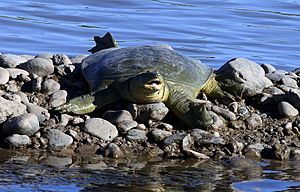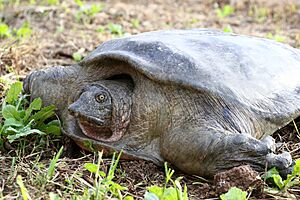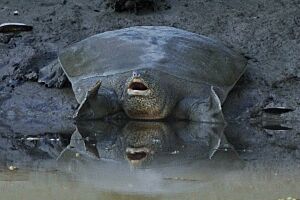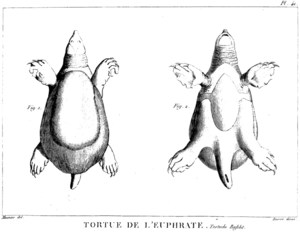Euphrates softshell turtle facts for kids
Quick facts for kids Euphrates softshell turtle |
|
|---|---|
 |
|
 |
|
| Conservation status | |
| Scientific classification | |
| Genus: |
Rafetus
|
| Species: |
euphraticus
|
| Synonyms | |
|
|
The Euphrates softshell turtle (Rafetus euphraticus) is a special kind of softshell turtle. It's also known as the Mesopotamian softshell turtle. These turtles live in the big Euphrates–Tigris river basin. You can find them in countries like Iraq, Syria, Turkey, and parts of Khūzestān Province in Iran.
Sadly, the Euphrates softshell turtle is an endangered species. This means there aren't many left, and they are at risk of disappearing forever. Their biggest problems are losing their homes and changes to their environment. This often happens because of dams being built. They are also harmed by pollution and sometimes by fishermen.
Contents
How We Discovered This Turtle
Western scientists first learned about the Euphrates softshell turtle a long time ago. In June 1797, a French scientist named Guillaume-Antoine Olivier shot one of these turtles. He was crossing the Euphrates River near a place called Anah.
Local people told Olivier that the turtle's meat wasn't good to eat. But they said its fat was a great medicine for skin problems. Olivier named the turtle Testudo rafcht because the local Arabs called it rafcht.
Later, it was found that the name al-rafš (الرفش) in Arabic means "the spade" or "the shovel". This name probably refers to the shape of the turtle's carapace (its upper shell). Olivier shared his findings with François Marie Daudin, who officially described the turtle in his book in 1801.
Over time, the turtle's name changed a bit. In 1864, John Edward Gray gave it the name Rafetus euphraticus. This is the scientific name we still use today.
What Do They Look Like?
This freshwater turtle can grow quite large! It can weigh up to 20 kg (44 lb), which is about the same as a medium-sized dog. Its shell is smooth and leathery, and it can be up to 68 cm (2.2 ft) long.
Both male and female turtles look very similar in size and appearance. Their upper shell is usually a dull olive green. Sometimes, they might have faint spots, especially on their head. Occasionally, you might see one that is dark brown or even black.
Where Do They Live?
The Euphrates softshell turtle lives in many different freshwater places. You can find them in rivers, streams, lakes, ponds, reservoirs, and marshlands. They really like areas where the water is shallow and calm. They also prefer places with sandy banks and lots of fish, especially cyprinids (a type of fish).
Even though they like calm, shallow water, these areas are often next to deeper, faster-flowing water. In the fast-moving Euphrates River, they usually stay in side-branches or quiet backwaters. But in parts of the Tigris River where the water flows slower, they can even be found in the main part of the river.
These turtles often warm themselves in the sun on the banks of rivers. Some stay in shallow water to avoid being fully on land. They also sometimes bury themselves in the mud or sand at the bottom of the water.
How Do They Behave?
The Euphrates softshell turtle is mostly active during the day. However, they can sometimes be seen moving around at night too. In some parts of their home range, they are not seen very often during the winter. This is probably because the water gets too cold for them.
What Do They Eat?
Scientists are still learning exactly what these turtles like to eat. For a long time, people thought they only ate meat. They are sometimes seen eating dead animals. Fishermen also complain that these turtles take fish from their nets. They can even be attracted by a bag of lamb blood in the water!
But it's not just meat. Some turtles have been caught with watermelon as bait. One turtle even pooped out a partially digested tomato! Farmers in the area say that these turtles sometimes eat their crops.
A study looked at what was in the poop of 30 turtles. It found mostly parts of crabs and plants. But it also found insects, birds, fish, and even bits of the riverbed. This shows that the Euphrates softshell turtle is an omnivore. This means it eats both plants and animals, and it's an "opportunistic" eater, meaning it will eat whatever food it can find easily.
Reproduction and Life Cycle
Euphrates softshell turtles lay their eggs at certain times of the year. The exact timing depends on where they live. The female turtle digs a nest in the bank of a river. This nest can be up to 50 cm (1.6 ft) deep. The nesting spot can be bare sand or a mix of sand and soil with plants. One nest was found about 4.1 m (13 ft) away from the water's edge, on a sandy bank that sloped quite a bit.
Each nest can hold up to 32 eggs. The eggs are white and about 2.3–3.0 cm (0.9–1.2 in) wide. When the baby turtles hatch, their shells are about 3.9–5.5 cm (1.5–2.2 in) long. In some areas, a female turtle might lay eggs twice in one season. Adult turtles often have marks from claws or bites. This shows that they can be aggressive with each other.
Why Are They Endangered?
The Euphrates softshell turtle is an endangered species. The main reasons for this are habitat loss and changes to their environment. Pollution and being killed by fishermen are also problems, but less common.
A huge threat is the building of dams. Dams change how much sediment (sand and dirt) is in the water and how warm the water is. They can also flood areas where the turtles live. For example, all the turtles in the Halfeti region disappeared after the Atatürk Dam was built. This might have been because the water became too cold. The Ilısu Dam also flooded some places where these turtles were known to lay their eggs. Many more dams are planned for the Euphrates-Tigris river system.
Even with these threats, there's some good news. These turtles seem to be able to use nesting spots near people. They are not easily bothered by general noise or activity. When they are basking on land, they are very shy. They quickly go back into the water if they sense any danger. They have also been seen living in places made by humans, like reservoirs and canals near cities.
Despite being endangered, there aren't many special projects to help this species in most of the places it lives. However, there is one project happening in Iran's Khuzestan Province to protect them.




